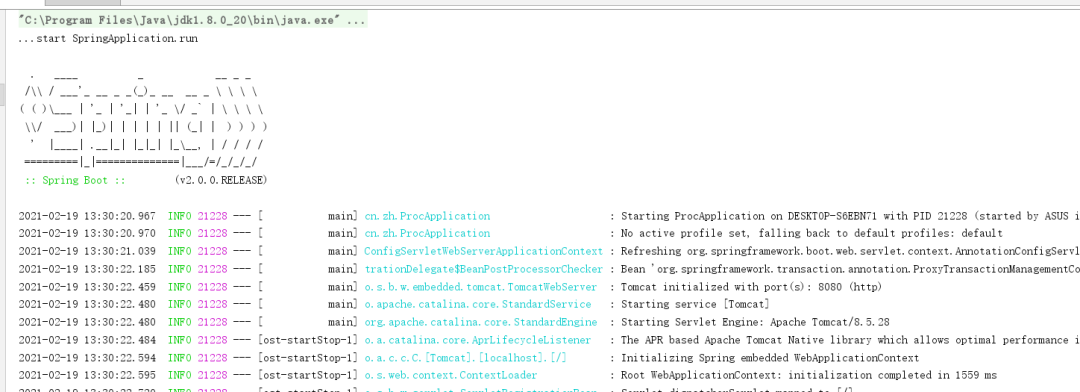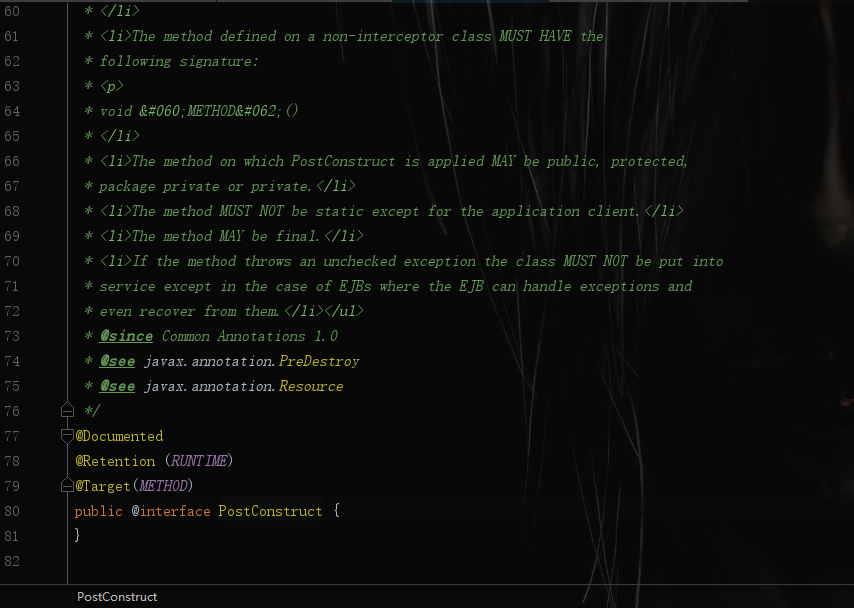假设有这么一个需求,要求在项目启动过程中,完成线程池的初始化,加密证书加载等功能,你会怎么做?如果没想好答案,请接着往下看。今天介绍几种在Spring Boot中进行资源初始化的方式,帮助大家解决和回答这个问题。
CommandLineRunner
定义初始化类
MyCommandLineRunner实现
CommandLineRunner接口,并实现它的run()方法,在该方法中编写初始化逻辑注册成Bean,添加
@Component注解即可示例代码如下:
package cn.zh.controller;
import org.springframework.boot.CommandLineRunner;
import org.springframework.core.annotation.Order;
import org.springframework.stereotype.Component;
@Componentpublic class MyCommandLineRunner implements CommandLineRunner {
@Override
public void run(String... args) throws Exception {
System.out.println("项目初始化---------------11");
}
}
实现了 CommandLineRunner 接口的 Component 会在所有 Spring Beans 初始化完成之后, 在 SpringApplication.run() 执行之前完成。下面通过加两行打印来验证我们的测试。
package cn.zh;
import org.springframework.boot.SpringApplication;
import org.springframework.boot.autoconfigure.SpringBootApplication;
@SpringBootApplication
public class ProcApplication {
public static void main(String[] args) {
System.out.println("...start SpringApplication.run");
SpringApplication.run(ProcApplication.class,args);
System.out.println("....end SpringApplication.run");
}
}

ApplicationRunner
定义初始化类
MyApplicationRunner实现
ApplicationRunner接口,并实现它的run()方法,在该方法中编写初始化逻辑注册成Bean,添加
@Component注解即可示例代码如下:
package cn.zh.controller;
import org.springframework.boot.ApplicationArguments;
import org.springframework.boot.ApplicationRunner;
import org.springframework.core.annotation.Order;
import org.springframework.stereotype.Component;
import javax.annotation.PostConstruct;
@Component
public class MyApplicationRunner implements ApplicationRunner {
@Override
public void run(ApplicationArguments args) throws Exception {
System.out.println("项目初始化二---------");
}
}
可以看到,通过实现 ApplicationRunner 接口,和通过实现 CommandLineRunner 接口都可以完成项目的初始化操作,实现相同的效果。两者之间唯一的区别是 run() 方法中自带的形参不相同,在 CommandLineRunner 中只是简单的String... args形参,而 ApplicationRunner 则是包含了 ApplicationArguments 对象,可以帮助获得更丰富的项目信息。

@Order
如果项目中既有实现了 ApplicationRunner 接口的初始化类,又有实现了 CommandLineRunner 接口的初始化类,那么会是哪一个先执行呢?测试告诉我们,答案是实现了 ApplicationRunner 接口的初始化类先执行,我想这点倒是不需要大家过分去关注为什么。但如果需要改变两个初始化类之间的默认执行顺序,那么使用 @Order 注解就可以帮助我们解决这个问题。

@Component
@Order(1)
public class MyCommandLineRunner implements CommandLineRunner {
/**
* Callback used to run the bean.
*
* @param args incoming main method arguments
* @throws Exception on error
*/
@Override
public void run(String... args) throws Exception {
System.out.println("项目初始化---------------11");
}
}
@Component
@Order(2)
public class MyApplicationRunner implements ApplicationRunner {
@Override
public void run(ApplicationArguments args) throws Exception {
System.out.println("项目初始化二---------");
}
@PostConstruct
public void init(){
System.out.println("@PostConstruct初始化");
}
}



@PostConstruct
使用 @PostConstruct 注解同样可以帮助我们完成资源的初始化操作,前提是这些初始化操作不需要依赖于其它Spring beans的初始化工作。

可以看到 @PostConstruct 注解是用在方法上的,写一个方法测试一下吧。
@PostConstruct
public void init(){
System.out.println("@PostConstruct初始化");
}
注意:
只有一个非静态方法能使用此注解
被注解的方法不得有任何参数
被注解的方法返回值必须为void
被注解方法不得抛出已检查异常
此方法只会被执行一次
综上,使用
@PostConstruct注解进行初始化操作的顺序是最快的,前提是这些操作不能依赖于其它Bean的初始化完成。通过添加@Order注解,我们可以改变同层级之间不同Bean的加载顺序。
InitializingBean
InitializingBean 是 Spring 提供的一个接口,只包含一个方法 afterPropertiesSet()。凡是实现了该接口的类,当其对应的 Bean 交由 Spring 管理后,当其必要的属性全部设置完成后,Spring 会调用该 Bean 的 afterPropertiesSet()。
@Component
public class MyListener1 implements InitializingBean {
@Autowired
private ShopInfoMapper shopInfoMapper;
@Override
public void afterPropertiesSet() {
//使用spring容器中的bean
//System.out.println(shopInfoMapper.selectById("1").getShopName());
System.out.println("项目启动OK");
}
}
ApplicationListener
ApplicationListener 就是spring的监听器,能够用来监听事件,典型的观察者模式。如果容器中有一个ApplicationListener Bean,每当ApplicationContext发布ApplicationEvent时,ApplicationListener Bean将自动被触发。这种事件机制都必须需要程序显示的触发。
其中spring有一些内置的事件,当完成某种操作时会发出某些事件动作。比如监听ContextRefreshedEvent事件,当所有的bean都初始化完成并被成功装载后会触发该事件,实现ApplicationListener接口可以收到监听动作,然后可以写自己的逻辑。
同样事件可以自定义、监听也可以自定义,完全根据自己的业务逻辑来处理。所以也能做到资源的初始化加载。
@Component
public class MyListener1 implements ApplicationListener {
@Override
public void onApplicationEvent(ApplicationEvent applicationEvent) {
//打印出每次事件的名称
System.out.println(applicationEvent.toString());
if (applicationEvent instanceof ApplicationReadyEvent) {
System.out.println("项目启动OK");
}
}
}

(完)
源于:cnblogs.com/zouhong/p/14415713.html






















 893
893











 被折叠的 条评论
为什么被折叠?
被折叠的 条评论
为什么被折叠?








